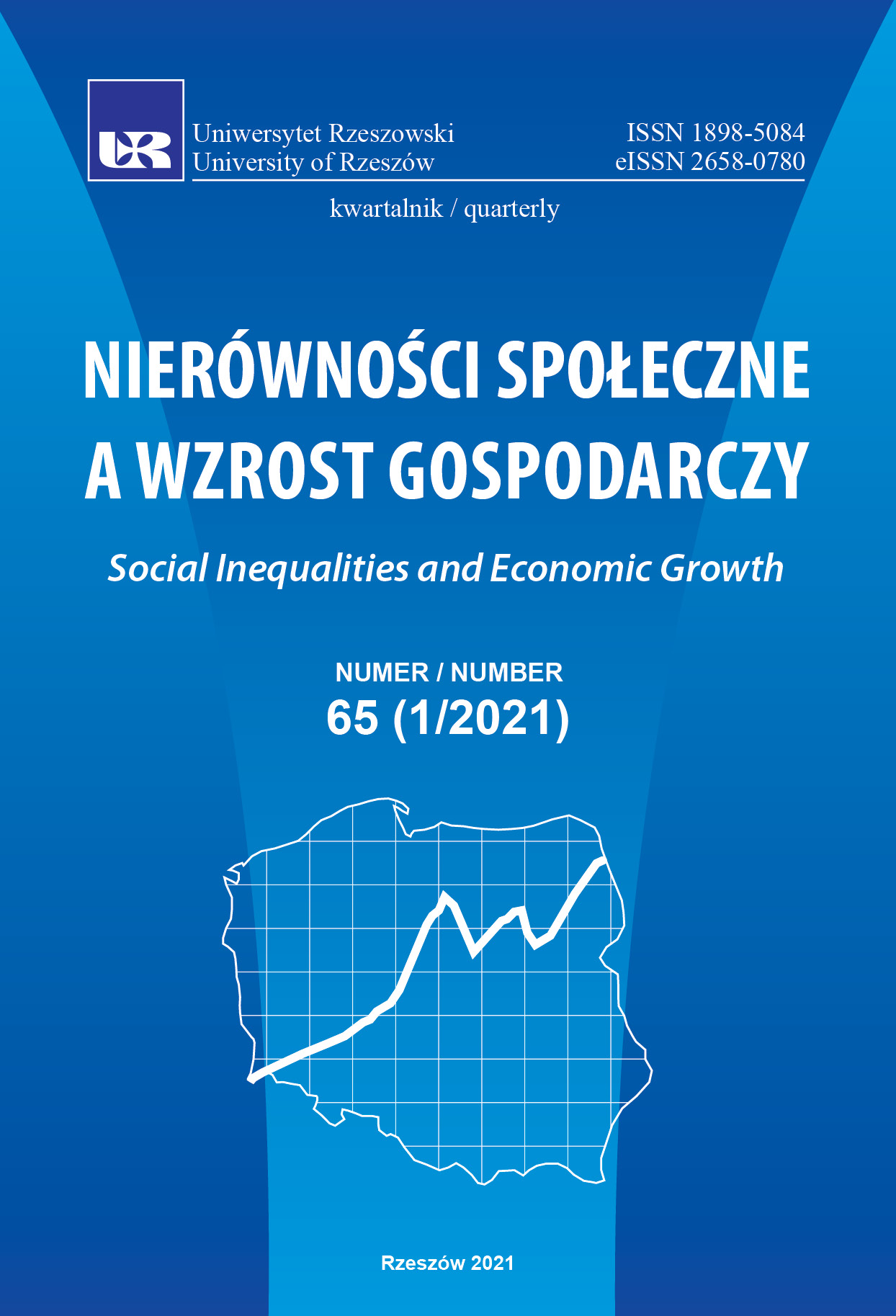Taxonomic methods in similarity examination of Lubuskie voivodeship in comparison to other European Union regions
DOI:
https://doi.org/10.15584/nsawg.2021.1.7Keywords:
taxonomic methods, Gower’s distance measure, chart for an object, Lubuskie voivodeship, development differentiation across regionsAbstract
In the territorial profile of the European Union, large differences may be observed between economically better and less developed regions. Therefore, in its policy, much attention is focussed on the less developed regions. Such regions include disadvantaged, remote, sparsely populated and border regions. The Lubuskie voivodeship examined in the article should be included among them.
This paper attempts to define the similarities and differences of this province in comparison to other regions of the European Union on the basis of typical features such as its geographical location and area, population density, land use and climatic conditions. For this purpose, 266 EU regions were studied, of which a group of 33 similar regions was identified by means of the complete linkage method. Next, these regions were analysed to indicate which of them, with similar geographical and natural conditions, could constitute a model for it, achieving more favourable economic results measured by the level of GDP per capita. The similarity between regions was examined by applying the Gower distance measure for quantitative and qualitative characteristics. The test results were visualised using a dendrogram and a taxonomic chart of the object under study. The data for the research was taken from the databases of Eurostat, the European Statistical Office, and Climate-Data.org. The collected data define the situation in EU regions as of 2017 or the last year available.
Based on the conducted research, 9 EU regions can be selected as model regions for the Lubuskie voivodeship. These are regions from the following countries: Germany (5 regions), as well as France, Austria, Belgium, and the Czech Republic (1 region each). More closely examining the management methods of the regions from the above-mentioned countries, the functioning of industry, agriculture and transport in their area, and the promotion of regionally produced products would be reasonable for the needs of the regional policy of the Lubuskie voivodeship.
Downloads
References
Adamiec, J. (2017). Polityka regionalna Unii Europejskiej. Rozwój Regionalny. Studia Biura Analiz Sejmowych Kancelarii Sejmu, 1(49), 63–85.
Atlas Statystyczny. Pobrane z: https://ec.europa.eu/eurostat/statistical-atlas/gis/viewer/?-config=typologies.json& (2020.03.05).
Burek, R. (red.). (2002). Encyklopedia PWN. Warszawa: Wydawnictwo Naukowe PWN.
Baza Danych Eurostat. Pobrane z: https://ec.europa.eu/eurostat/data/database (2020.03.05).
Climate-Data.org. Pobrane z: https://pl.climate-data.org (2020.03.05).
Domański, R. (2006). Gospodarka przestrzenna. Podstawy teoretyczne. Warszawa: Wydawnictwo PWN.
Gaczek, W. M. (red.). (2005). Innowacje w rozwoju regionu. Poznań: Wydawnictwo AE.
Gower, J. C. (1971). A General Coefficient of Similarity and Some of Its Properties. Biometrics, 27(4), 857–874. DOI: 10.2307/2528823
Grabiński, T. (2003). Analiza taksonometryczna krajów Europy w ujęciu regionów. Kraków: Wydawnictwo AE.
Kruczek, Z., Zmyślony, P. (2010). Regiony turystyczne. Kraków: Proksenia.
Kolenda, M. (2001). Taksometryczna mapa dla obiektu. Prace Naukowe Akademii Ekonomicznej we Wrocławiu, 906. Taksonomia, 8, 97–106.
Kolenda, M. (2006). Taksonomia numeryczna. Wrocław: Wydawnictwo AE.
Korenik, S. (2011). Region ekonomiczny w nowych realiach społeczno-gospodarczych. Warszawa: Wydawnictwo CeDeWu.
Kuciński, K. (1990). Podstawy teorii regionu ekonomicznego. Warszawa: Wydawnictwo PWN.
Madej, T. (1998). Regionalna polityka społeczno-gospodarcza. Szczecin: Wydawnictwo Naukowe US.
Maechler, M., Rousseeuw, P., Struyf, A., Hubert, M., Hornik, K. (2019). Cluster: Cluster Analysis Basics and Extensions. R package version 2.1.0. Pobrane z: https://cran.r-project.org/web/packages/cluster/cluster.pdf (2020.03.05).
Markowska, M., Sokołowski, A., Strahl, D., Sobolewski, M. (2015). Klasyfikacja dynamiczna regionów Unii Europejskiej szczebla NUTS 2 pod względem wrażliwości na kryzys ekonomiczny w obszarze rynek pracy. Humanities and Social Sciences, 22(2), 37–50. DOI: 10.7862/rz.2015.hss.18
Młodak, A. (2006). Analiza taksonomiczna w statystyce regionalnej. Warszawa: Difin.
Panek, T. (2009). Statystyczne metody wielowymiarowej analizy porównawczej. Warszawa: Oficyna Wydawnicza SGH w Warszawie.
Parysek, J. J. (2001). Podstawy gospodarki lokalnej. Poznań: Wydawnictwo Naukowe UAM.
Pastuszka, S. (2019). Regiony problemowe we Włoszech, w Niemczech i Polsce oraz uwarunkowania ich rozwoju. Kielce: Wydawnictwo UJK.
Plan Zagospodarowania Przestrzennego Województwa Lubuskiego. Tom I (2018). Zielona Góra: Zarząd Województwa Lubuskiego.
Strahl, D. (red.). (2010). Innowacyjność europejskiej przestrzeni regionalnej a dynamika rozwoju gospodarczego. Wrocław: Wydawnictwo UE.
Szewczuk, A., Kogut-Jaworska, M., Zioło, M. (2011). Rozwój lokalny i regionalny. Teoria i praktyka. Warszawa: C. H. Beck.
Tkocz, J. (2005). Podstawy geografii społeczno-ekonomicznej. Katowice: Wydawnictwo UŚ.
Walesiak, M. (2002). Uogólniona miara odległości w statystycznej analizie wielowymiarowej. Wrocław: Wydawnictwo AE.
Zwiększanie wzrostu gospodarczego i spójności w regionach przygranicznych UE (2017). Bruksela: Komisja Europejska. Pobrane z: https://ec.europa.eu/regional_policy/sources/docoffic/2014/boosting_growth/com_boosting_borders_pl.pdf (2020.03.05).
Downloads
Published
How to Cite
Issue
Section
License

This work is licensed under a Creative Commons Attribution-ShareAlike 4.0 International License.


